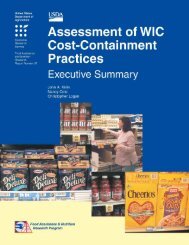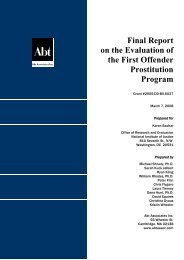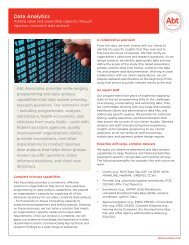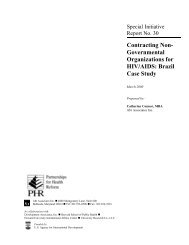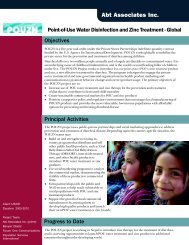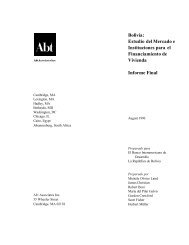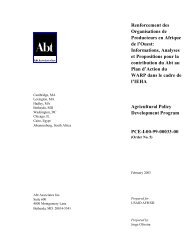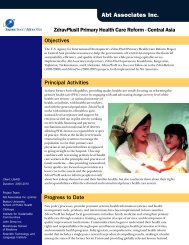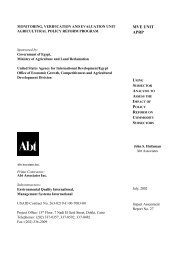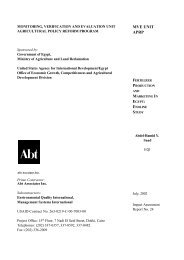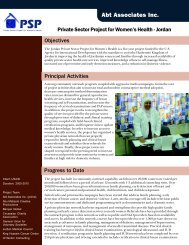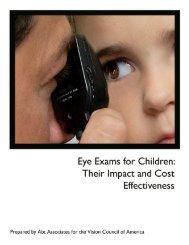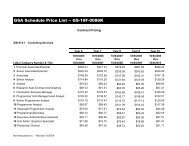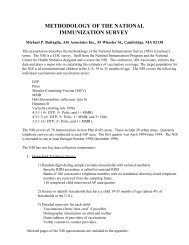What America's Users Spend on Illegal Drugs 1988-2000 - National ...
What America's Users Spend on Illegal Drugs 1988-2000 - National ...
What America's Users Spend on Illegal Drugs 1988-2000 - National ...
- No tags were found...
You also want an ePaper? Increase the reach of your titles
YUMPU automatically turns print PDFs into web optimized ePapers that Google loves.
of the tests for cocaine, 1.3 percent for heroin, 2.0 percent for methamphetamine, and 6.3 percent formarijuana found evidence of drug use. In Federal pris<strong>on</strong>s, 0.4 percent of the tests for cocaine, 0.4percent for heroin, 0.1 percent for methamphetamine, and 1.1 percent for marijuana were positive.”C. Harlow, Drug Enforcement and Treatment in Pris<strong>on</strong>, 1990 (NCJ-134724, July 1992). Thesepercentages are probably high because tests are most likely to be c<strong>on</strong>ducted when drug use issuspected. In any case, drug use in pris<strong>on</strong>s cannot account for much of the drug use that occurs inAmerica. Sources at the Nati<strong>on</strong>al Institute <strong>on</strong> Drug Abuse c<strong>on</strong>sider drug use by those in residentialtreatment facilities to be minimal.6. Evidence that a large segment of the drug-using populati<strong>on</strong> is excluded from the NHSDA comes froma number of sources. According to the 1991 NHSDA, drug use is twice as high am<strong>on</strong>g resp<strong>on</strong>dentswho lived in households c<strong>on</strong>sidered unstable than it is am<strong>on</strong>g those who lived in more stableenvir<strong>on</strong>ments, indicating that the NHSDA’s bias toward reporting <strong>on</strong> stable households is likely tomiss many heavy drug users. Additi<strong>on</strong>al evidence comes from interviews with nearly 35,000intravenous drug users who were c<strong>on</strong>tacted by Nati<strong>on</strong>al Institute <strong>on</strong> Drug Abuse-sp<strong>on</strong>soredresearchers as part of an AIDS outreach project. Abt Associate’s tabulati<strong>on</strong>s show that of these drugusers, an estimated 40 percent lived in unstable households and about 10 percent could be c<strong>on</strong>sideredhomeless.Available evidence indicates that NHSDA’s resp<strong>on</strong>dents understate heavy drug use. A. Harrell, K.Kapsak, I. Caiss<strong>on</strong>, and P. Wirtz, ”The Validity of Self-Reported Drug Use Data: The Accuracy ofResp<strong>on</strong>ses <strong>on</strong> C<strong>on</strong>fidential Self-Administered Answer Sheets,” paper prepared for the Nati<strong>on</strong>alInstitute <strong>on</strong> Drug Abuse, C<strong>on</strong>tract Number 271-85-8305, December 1986. M. Fendrich, T. Johns<strong>on</strong>,S. Sudman, J. Wislar and V. Spiehler, “Validity of Drug Use Reporting in a High-Risk CommunitySample: A Comparis<strong>on</strong> of Cocaine and Heroin Survey Reports with Hair Tests,” American Journalof Epidemiology 149(10): 955:62, 1999. C<strong>on</strong>sistent with these observati<strong>on</strong>s, the Substance AbuseMental Health Services Administrati<strong>on</strong> reports that virtually no heroin addicts answer the Nati<strong>on</strong>alHousehold Survey <strong>on</strong> Drug Abuse. Substance Abuse Mental Health Services Administrati<strong>on</strong>,Preliminary Estimates from the 1993 Nati<strong>on</strong>al Household Survey <strong>on</strong> Drug Abuse (June 1994).A comparis<strong>on</strong> of the demographic characteristics of the heavy cocaine users in the NHSDA with thoseof heavy cocaine users based <strong>on</strong> other sources (the Drug Use Forecasting program, the Drug AbuseWarning Network, and the Nati<strong>on</strong>al AIDS Dem<strong>on</strong>strati<strong>on</strong> Research project) shows a markeddifference between those populati<strong>on</strong>s and the <strong>on</strong>e represented in the NHSDA. Incomes are greater,unemployment is lower, and there are fewer resp<strong>on</strong>dents using more than <strong>on</strong>e drug in the NHSDA.D. Hunt and W. Rhodes, “Characteristics of Heavy Cocaine <str<strong>on</strong>g>Users</str<strong>on</strong>g> Including Polydrug Use, CriminalBehavior, and Health Risks,” paper prepared for Office of Nati<strong>on</strong>al Drug C<strong>on</strong>trol Policy (ONDCP),December 14, 1992.Finally, estimates of heavy drug use reported in the NHSDA are difficult to rec<strong>on</strong>cile with other datasources maintained by the Substance Abuse Mental Health Services Administrati<strong>on</strong>, especially withreports of the treatment for cocaine or heroin. These incompatibilities are discussed later in thisreport.50



